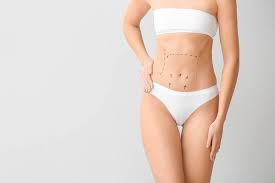The drains are a necessary part of the tummy tuck procedure, and they should remain in for approximately two weeks. After the surgery, you will be asked to wear compression garments for about two weeks, and you may also need to use support stockings for up to six weeks. The drain will be removed after two days, but it is important that you do not remove it yourself.
During the first week after your tummy tuck, you should rest as much as possible and keep your activity level low. Your doctor may also prescribe pain medication to help manage any discomfort or swelling that persists post-surgery. Your doctor will likely ask you to return for a follow up appointment within three weeks of your operation date so he or she can monitor your progress and ensure that everything is healing properl.
Read on to learn more about How Long Do Drains Stay In After Tummy Tuck, How to Lower Your Chances for DVT After Surgery and How To Prevent Blood Clots After Tummy Tuck Surgery

How Long Do Drains Stay In After Tummy Tuck
For men and women who want a flatter, firmer stomach, a tummy tuck is an excellent option. At my practice in Richmond, VA, I perform tummy tuck surgery to remove excess skin and fat around the waistline and create a slim, taut midsection.
One question I hear during my tummy tuck consultations is about the use of post-surgical drains. In this blog, you’ll learn why drains are placed, how they help you heal, and what you can do for a fast recovery.
Why are drains needed after a tummy tuck?
Drains are used to help remove excess fluid that accumulates after surgery. During your tummy tuck procedure, skin and fat are separated from the underlying muscle, creating a large abdominal flap. The body produces a type of fluid called serous fluid to promote healing, and it can accumulate between the skin and muscle, known as the “dead space.” If this happens, complications can occur, such as seroma or infection.
To avoid this, 2 drains are usually placed beneath the skin to help remove serous fluid and any residual blood that may be present. These drains look like small tubes with bulbs attached. By squeezing the bulb, you create a manual suction that helps flush away excess fluid.
Drains are usually placed by your plastic surgeon at the end of your tummy tuck surgery. They are left in place anywhere from a few days to a few weeks after tummy tuck surgery. Most of my patients have their drains removed about 1 week after their operation.
Will drains prevent me from returning to my normal day-to-day activities?
Post-surgical drains will not hinder your recovery or prevent you from doing normal daily tasks. In fact, your drains actually help you recover more quickly so you can get back to your regular routine faster. The key is to keep your drains clean, protected, and discreet while they are still in. Gentle showers or sponge baths will keep bacteria at bay and won’t irritate drains or sutures.
Some of my clients purchase post-surgical drain belts for when they are outside the home. These garments are worn under clothing throughout the day and can usually carry between 2 to 4 drains.
How do you keep drains clean?
Keeping your drains clean is important for your safety and recovery. If bacteria accumulate, it can result in infection.
You’ll want to keep the skin around the drain and the incision site clean and dry. Avoid perfumed soaps and lotions, as these can irritate the skin. Use a mild antibacterial soap and warm water to clean the area regularly. Do not scrub the area or use harsh, abrasive sponges, such as a loofah. Use a soft washcloth and make sure you wash your hands before touching your incision or drain.
How long will my drains stay in?
How long you have your drains will depend on the extent of your procedure and your body’s ability to heal. I can often tell when a patient is ready to have their drains removed because they are not producing much fluid and the color of any remaining fluid is normal. For most people, this usually occurs about 7 to 14 days after surgery.
How to Lower Your Chances for DVT After Surgery
While you’re recovering at the hospital, it’s important to keep your blood moving to lower your chances for blood clots. The DVT prevention plan your doctor makes for you might include:
Blood thinner medicines. These are also called anticoagulants. They make it harder for your blood cells to stick together and form clots. You take them by mouth, shot, or through an IV.
Doctors don’t prescribe blood thinners after all surgeries, because they can cause excessive bleeding. Your doctor will decide if they’re right for you. You can ask them to explain the benefits and risks.
Simple movements. These can improve blood flow. Depending on the type of surgery you had, your care team might suggest gentle exercises like:
- Leg lifts while you’re in bed
- Moving your feet in a circle or up and down about 10 times an hour while you’re sitting in a chair or lying in bed
- Squeezing your calf and thigh muscles regularly
If you got your hip or knee replaced, your doctor might have you start working with a physical therapist the day after surgery.
You might need to take pain medicine so you can exercise comfortably.
If you can’t exercise after major surgery, ask your doctor if someone on your care team should massage your lower legs and move your legs through range-of-motion exercises.
Getting mobile. A nurse will help you get out of bed to move around as soon as possible after surgery. It’s good for your blood flow.
Elastic compression stockings. Your doctor may recommend these to help keep your blood flowing and to stop it from pooling in your veins, which could cause clots to form. Compression stockings fit snugly and may feel uncomfortable at first, but you may get used to them after you wear them a few times.
Compression device. This type of gadget applies pressure to your legs to get blood moving and prevent clots. They have names like “sequential compression device” or “intermittent pneumatic compression” device.
Your care team wraps plastic sleeves around your legs, and a connected pump inflates and deflates them. Take the sleeves off before you walk somewhere (like to the bathroom) so you don’t trip and fall. Your care team can help you remove them if you need a hand.
How to Help Prevent DVT Once You’re Home
Follow these tips after you leave the hospital and start recovering at home:
If your doctor gave you blood-thinning medication (anticoagulants), keep taking it exactly as prescribed. Ask the doctor or a pharmacist if you should avoid certain foods or drinks while you’re on the medicine. Also ask what to do if you accidentally skip a dose.
If your doctor wants you to use compression stockings, make sure they tell you often and how long to wear them. Check your legs and feet for redness or sores each time you take the stockings off. Call the doctor right away if you notice changes in your skin.
If the doctor wants you to use a compression device at home, follow their instructions on how to do so exactly. They’ll tell you how long and how often to use it. Remember to take the device’s sleeves off before you walk around.
Follow your doctor’s instructions on getting active again. Your doctor may keep certain activities off-limits at first. But in general, move as much as you can to keep your blood flowing.
If your care team had you doing gentle movement exercises in bed or in a chair at the hospital, keep doing these at home. You could also ask a loved one to help you move your arms and legs while you’re in bed or if you need to use a wheelchair.
How To Prevent Blood Clots After Tummy Tuck Surgery

Tummy tucks and body lifts can be life-changing procedures. The removal of skin and fat excess along with tightening of the abdominal wall can reverse many of the problems that occur following childbirth and/or weight loss. But make no mistake: even though tummy tucks and body lifts are cosmetic surgeries, they are still surgery. And every surgery has risks.
The most serious risk of any excisional body contouring procedure is blood clots. Due to the immobility associated with any major surgery (especially one that temporarily makes it more difficult to walk), there is a risk of blood clots forming in leg veins (deep venous thrombosis). If a clot “breaks off” and travels through the bloodstream to the lungs, it can suddenly and seriously impair oxygen exchange. This life-threatening condition is called a pulmonary embolus. It requires immediate treatment with blood thinners (to dissolve the clot) and oxygen.
Every plastic surgeon and plastic surgery patient should take these risks very seriously. The question: what can we do to prevent blood clots following tummy tuck and circumferential body contouring (body lift)? We have a protocol:
- DO NOT smoke for at least one month before surgery and one month after surgery. Smoking causes constriction of blood vessels, impairing blood flow and oxygenation. Smoking greatly increases your risk of blood clots (even if you are not undergoing surgery).
- DO NOT use contraceptives or hormone replacement therapy for at least one week before surgery and one week after surgery. These substances can increase your risk of blood clots (even if you are not undergoing surgery).
- DO walk regularly after surgery. Every time you want to eat or use the restroom, you must have a family member or friend help you to the kitchen or the bathroom. Regular meals in bed are just a bad idea. Walking helps pump blood through your leg veins, preventing clots from forming.
- DO use SCDs. Sequential compression devices (SCDs) are mechanical pumps that intermittently compress the leg veins, promoting circulation by simulating walking. We place these on all patients undergoing surgery in our nationally-accredited surgical facility, the West Plano Plastic Surgery Center. We send abdominoplasty (tummy tuck) and body lifting patients home with an SCD machine for the first few days to further reduce the risk of blood clots. I do not know of any other surgeon or surgery center that does this routinely, and I sincerely believe that they should.
- DO consider anticoagulants. Anticoagulants (blood thinners) can significantly reduce the risk of blood clots. Unlike #s 1 to 4 above, they do increase the risk of postoperative bleeding, so they must be used with caution. For example, I will not use an anticoagulant in a patient who bleeds excessively during surgery. However, in most patients undergoing excisional body contouring, I begin low dose Lovenox (low molecular weight heparin) in the first 24 hours after surgery and continue its use daily for a week.
With this protocol in place over the past five years, we have not experienced a single clotting-or bleeding-episode in a tummy tuck or body lift patient.
We want you to look great after surgery. But first and foremost, we want you to be safe!